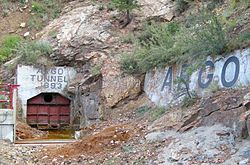Argo Tunnel
|
Argo Tunnel
|
|

Argo Tunnel in 2009
|
|
| Location | 2517 Riverside Dr., Idaho Springs, Colorado |
|---|---|
| Area | 20 acres (8.1 ha) |
| Built | 1893 |
| Architect | Multiple |
| NRHP Reference # | 78000836 |
| CSRHP # | 5CC.76 |
| Added to NRHP | January 31, 1978 |
The Argo Tunnel, originally called the Newhouse Tunnel (after Salt Lake City mining magnate Samuel Newhouse), is a 4.16-mile (6.69 km) mine drainage and access tunnel with its portal at Idaho Springs, Colorado, USA. The tunnel intersected nearly all the major gold mines between Idaho Springs and Central City, and is the longest such drainage tunnel in the Central City-Idaho Springs mining district.
The mines drained by the Argo Tunnel are no longer active, and the water draining out the tunnel was a source of pollution in Clear Creek until the US EPA began treating the water. Large drainage tunnels in other mining districts include the Sutro Tunnel on the in Nevada, and the Leadville Tunnel and the Yak Tunnel at Leadville, Colorado.
Although the tunnel itself is not open to the public, the associated gold ore mill and an adjacent gold mine are open to public tours.
The Argo Tunnel was started from its southern terminus at Idaho Springs in September 1893, and reached its final length of 4.16 miles (6.69 km) in November 1910, after several pauses in the work. The actual time spent driving the tunnel was nine years and seven months. The tunnel intersected nearly all the major mines between Idaho Springs and Central City.
The tunnel was built on an incline of one-half percent, so that water from the mine workings that it intersected would drain out the entrance at Idaho Springs, rather than having to be pumped out of the individual shafts. In addition, ore cars from the mines could roll downhill to the ore mill at the tunnel entrance, rather than the ore having to be hoisted out of the shafts and trucked to mills. The tunnel was driven in a north-northwest direction, perpendicular to the predominant orientation of the gold veins. It was hoped that the tunnel would intersect previously undiscovered gold veins, but there is no record that important new ore bodies were discovered.
The tunnel operated until January 1943, when miners working on the Kansas Lode near Nevadaville blasted into a water-filled mine working, and a large slug of water flooded out the tunnel entrance, killing the four miners. Shortly after the accident, the federal government ordered all gold mines in the US to shut down, to free men and material to mine metals considered more essential to the World War II war effort. The Argo Tunnel never reopened.
...
Wikipedia


